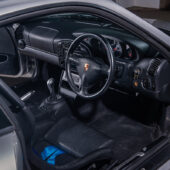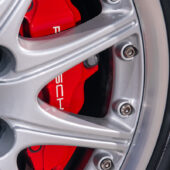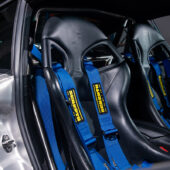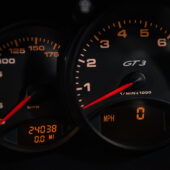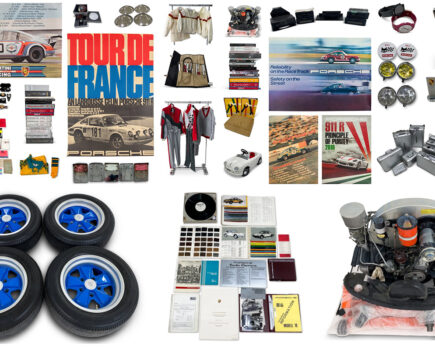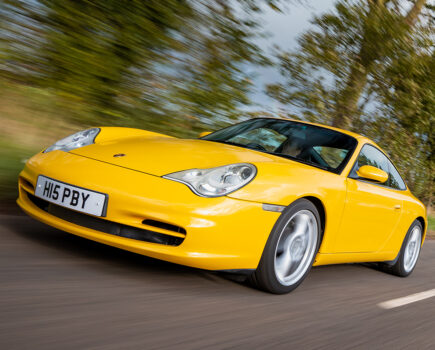Once considered the least desirable go-faster 911, the 996 GT3 is now finding its feet as a coveted performance icon
Words: Dan Furr Images: Dan Sherwood
Owning a GT3 is on the bucket list of many Porsche enthusiasts, and though the 996-generation 911 received fierce criticism from Porsche purists outraged at the end of the air-cooled era, the GT3 was widely celebrated by all marque enthusiasts – its undeniable talents more than making up for any reservations about water-cooling or ‘fried egg’ headlights.
Introduced in 1999 two years after the 996’s debut, the GT3 was a homologation model to enable Porsche to compete in FIA GT3 Cup racing. Much like the Carrera RS 2.7, the GT3 was configured with a firm focus on racing, resulting in deletion of rear seats, sound proofing material, sunroof and audio equipment; comfort items such as air-conditioning and a basic compact disc player (with accompanying centre-console disc magazine) could be optioned as no-cost extras. A model-specific body kit – subtle by today’s standards, even with a large rear wing stealing the show – and lightweight two-piece multi-spoke wheels helped the GT3 to stand out from the rest of the 996 pack.
But it was the car’s superbly engineered boxer engine which got enthusiasts most excited. Derived from the 911 GT1 race car, the near 360bhp 3.6-litre normally aspirated ‘Mezger’ flat-six has gone down in history as one of the 911’s greatest powerplants. Joined by a powerful braking system, custom suspension, a lowered ride height and a six-speed gearbox offering easy swapping of ratios, the engine featured lightweight internals and enabled the GT3 to hit 62mph in just 4.8 seconds, topping out at 188mph and delivering a respectable 273lb-ft torque.
The original GT3 is the lightest in the model line-up to date, tipping scales at 1,350kg (2003’s facelift 996 GT3 added thirty kilos). A no-cost Clubsport variant equipped with bucket seats, a half roll cage, safety harnesses and fire extinguisher was also available, but even a standard 996 GT3 is a rare beast, with only 1,868 produced and just 100 right-hookers making their way to UK shores.
The 996 GT3 pictured here was at time of writing a sales car in possession of Suffolk-based independent Porsche tuning, maintenance and sales specialist, PIE Performance. Having covered only 24k miles from new, it’s been well looked after. Even so, PIE head honcho, Chris Lansbury, suggests mileage shouldn’t really be a concern with these 911s. “The Mezger engine is largely bulletproof,” he assures us. “Nevertheless, this doesn’t stop it suffering from the effect of less than frequent oil changes. There’s also potential for high levels of suspension wear through regular track use. It’s no use looking at things like tyres to determine if the car has been in the wars. Anyone can fit new rubber to help sell a 911. Be more focused on the condition of the car’s underside, which takes the brunt of abuse due to being significantly lower to the ground than the 996 Carrera.”
In addition to checking to make sure the car you’re thinking about buying is supported by a wealth of paperwork to support claims of regular servicing (“cars used frequently at the track should really be treated to an oil change either side of a session at a circuit”), he recommends investing in a pre-purchase inspection from a marque specialist familiar with the GT3 line.
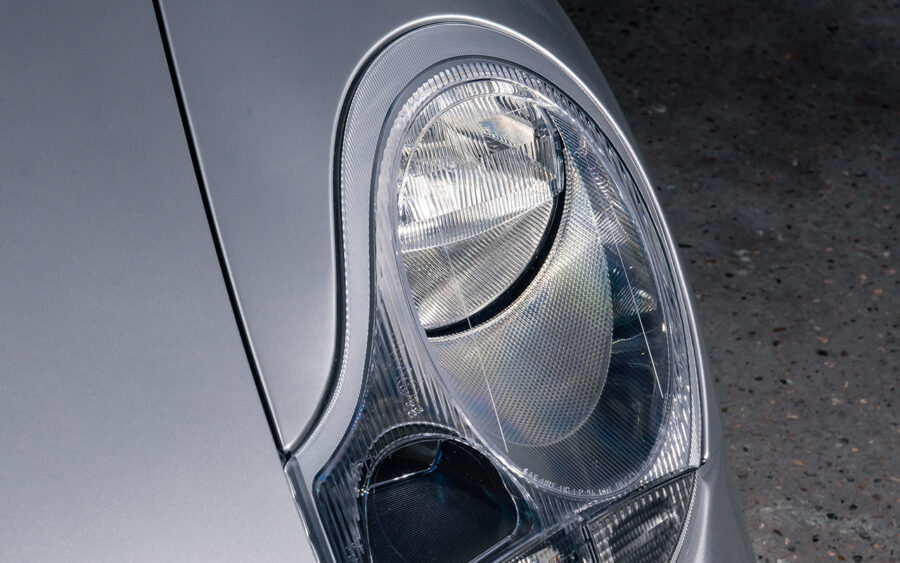
Talking of which, prices of early GT3s have rocketed in the past few years, making now a good time to get in on the act. “It’s typical of the 911 scene,” Chris laughs. “Hardly anybody wanted these cars, now everyone is clamouring to get hold of one. Buy wisely, but do so before it’s too late. The price of ownership is only going one way.”
As much as any other 911, the 996 GT3 epitomises Porsche’s design and manufacturing excellence. A perfect blend of road-going sportscar and track-oriented elaborations, it’s a direct manifestation of a philosophy going back way beyond the much-vaunted Carrera RS 2.7 to evolutions of the 356, such as the 356 Carrera of 1955. The company has always sought to implant its road-going models with lessons learned at the track and, at the Geneva Motor Show in April 1999, the 996 GT3 was announced. It certainly looks the part, with its deep front spoiler and airdam, aerodynamically configured sills and fixed double-decker swan neck rear wing.
The 996 GT3 is the offspring of Andreas Preuninger, head of Porsche’s GT series production department and manager of Porsche High Performance Cars. A renowned purist, he designed specification to encourage maximum driver involvement. For this reason, Tiptronic and PDK transmissions were off the menu. The Carrera 4’s body shell (incorporating front-end stiffening) was adapted to house the GT3’s dry-sump oil tank, different engine mounts and a larger fuel cell. At the time, standard 996 Carreras were powered by a 3.4-litre flat-six, but in order to stand the strains and stresses of on-track use, the GT3 was equipped with the aforementioned 3.6-litre ‘Mezger’. The engine came with 11.7:1 compression ratio, VarioCam timing adjustment and four-valves-per-cylinder, while its plasma-nitrided crankshaft and titanium connecting rods allowed the unit to rev significantly higher than the standard flat-six. The six-speed G96/50 transmission, dual-mass flywheel and forty-percent limited slip differential were sourced from the 993 GT2 and, with close to 360bhp at 7,200rpm and 273lb-ft torque at 5,000rpm on model launch, the 996 GT3 was the most powerful normally aspirated 911 ever made. It remains one of the most sought-after.
The 996 Gen II GT3 appeared on the scene in 2004, coinciding with launch of the first GT3 RS. Model buffs reckon the GT3 was somewhat ‘toned down’ to provide contrast with the more aggressive model. Nevertheless, for the first time, the GT3 was available in the USA, a market historically wary of hotter evolutions. The Gen II presents several stylistic changes: the teardrop headlights are sourced from the Turbo — carried over to the rest of the 996 range, replacing the earlier ‘fried eggs’ and to further differentiate the 911 from the Boxster — while the front and rear PU skirts have revised slope angles to the inlets and air ducts, with subtly different curves and splitter. It’s the same at the back panel, which also displays revised contours. The ten-spoke rims are simplified to a single-piece ‘cloverleaf’, side skirts are moulded to enhance aero and the rear wing is configured as a platform on a pair of struts, becoming an ‘ironing board’ in place of the earlier GT3’s swan-neck biplane.
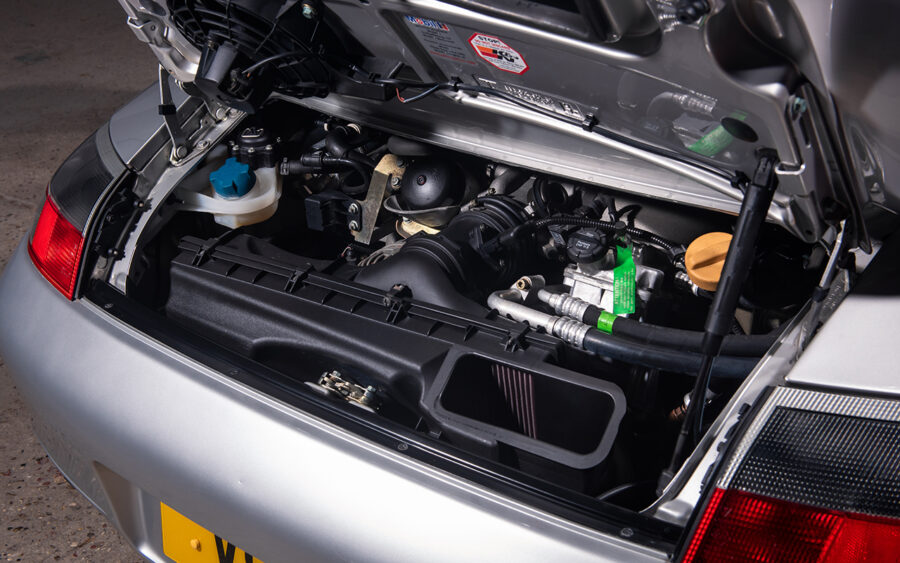
Engine and transmission
The 996 GT3 is powered by a 3.6-litre dry-sumped flat-six with motorsport pedigree — the unit can trace its roots to the 911 GT1 and 962 race cars, lineage which helps to explain the mix of old and modern technology, such as a late air-cooled 911 crankcase paired with two cylinder heads (as opposed to six) and water cooling. Accompanying the classic crankcase is a gearbox with a design also ‘lovingly borrowed’ from the air-cooled era. “Though these engines have a great reputation for being very reliable, even the newest 996 GT3 is closing in on its twentieth birthday,” Chris points out. “You should look closely for signs of oil and water leaks.”
He cites the external coolant pipes running around the outside of the engine as prime suspects for the drips you might find on your driveway. “A common complaint can be found where coolant pipes attach to the engine. They are slip-fit and held in place by a form of epoxy glue, which was intended to hold pipe collars in their housings and create a seal, but over time and through repeated heat cycles, this adhesive breaks down, causing the pipes to work free and a sudden loss of coolant, which could be catastrophic for the car’s engine. More importantly, it could also be very dangerous if the coolant pours out onto a busy circuit.”
Enthusiastic DIYers may have “bodged” the fix by pinning the pipes in place. “It’s fairly easy to drill through the cast housing, into the coolant pipe and then ‘pin’ the two together with a bolt secured with threadlock,” Chris continues. “This prevents the pipe from working its way free, but it isn’t the proper way to correct the problem. Ideally, the engine should be removed, the cast housings should be taken off and all affected parts should be thoroughly cleaned free of old adhesive. After this process, the coolant pipes can be TIG-welded to their respective cast housings, providing a thorough seal which will last the life of the engine. Extended rubber or silicone hoses can be used during reassembly.”
Considering only a hundred right-hand drive 996 GT3s were originally allocated to the UK market, Chris is proud to say PIE Performance takes care of nine surviving examples of this trailblazing 911. “They’re great cars,” he smiles. “The noise of the Mezger engine is intoxicating. Someone new to the 996 GT3 might think the model sounds a tad ‘agricultural’ on idle, but they’ll change their mind when at the track and climbing quickly through the upper rev range and on toward the redline. The noise is astonishing and extremely addictive!”
Radiator corrosion can be a problem on all 996s and the GT3 is no exception. The coolant radiators are housed behind the front bumper (along with the optional air-conditioning system’s condenser) and are susceptible to stone chips and corrosion resulting from dirt, salt and leaves coming in through the bumper air scoops. Sadly, many 996 owners don’t bother vacuuming these areas, allowing dirt and rotting leaves to fester, leaving plenty of time for damage to develop between servicing. Suspect radiators and/or condensers will need to be replaced to avoid overheating or the loss of air-conditioning.
Original GT3 gearboxes featured phosphor bronze synchromesh rings, which were updated to steel parts for the facelift 996 GT3 in 2003. Some owners retrofit the later parts to early cars. Limited-slip differentials are known to wear prematurely due to being configured with low-level preload, while clutches can feel heavy on GT3s used primarily as road cars. Replacement parts are expensive, but easy to come by.
“For 996 GT3s used in anger at the track,” Chris continues, “I recommend frequent gearbox oil changes. Renewing fluids is a cheap job which will help to achieve a long service life.”
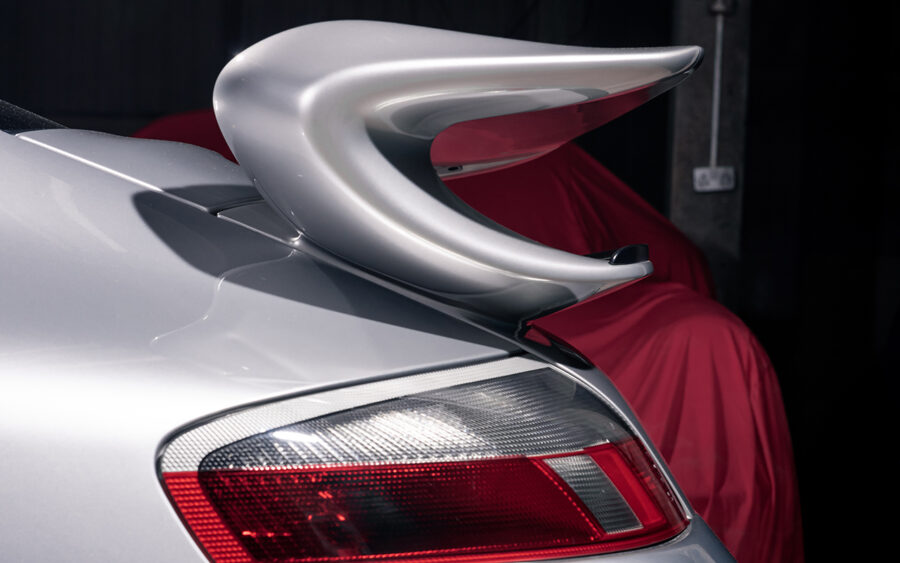
Bodywork
The easiest way to correctly verify the identity of the car you’re looking at is to check its Vehicle Identification Number (VIN). Make sure it matches what’s printed on the V5. Elsewhere on the same document, you’ll see the car’s engine number. Make sure it checks out.
Spend a tenner at mycarcheck.com, where you can download a history report outlining any insurance claims, change of registration number, recorded mileage and whether there is any outstanding finance on the GT3 you’re looking at. You should also enter the vehicle’s details into the DVLA’s online MOT database (hop online and visit bit.ly/dvlamot), a service which will return all passes, failures and advisories registered as far back as records are stored.
Additionally, take advantage of the Suncoast Parts Porsche VIN decoder (check it out at bit.ly/suncoastvin), which will provide you with a Porsche-specific build sheet in exchange for just $10. This document will let you know exactly how the car left the factory, including model specification and any Individual Equipment items optioned. We’ve lost track of the number of Porsche owners who have discovered their car makes use of a special feature they only found out about after ordering this report, though your local Porsche Centre or the car’s original dealer may be able to furnish you with the same information without charge.
The bodywork on the 996 is of the highest quality (Porsche provided a ten-year anti-rust warranty). With the exception of the area below the door catches (primarily early 996s), rust is rare and may therefore be evidence of a badly repaired smack. Check the bodywork carefully for dents and signs of repair. Also check underneath the car for a misshaped floorpan, another sure sign the car has been involved in an accident. Ask for details of the accident damage and repairs, and insist on seeing receipts for the work. Make sure you’re happy with the explanation and quality of repair before making an offer.
The GT3 was, of course, developed to be a circuit dweller. With this in mind, don’t be surprised to find stone chips on the front bumper and by the rear wheels. Underbody damage should be of greater concern. For this reason, no matter how tidy the car you’re looking at appears to be, invest in a pre-purchase inspection from a trusted marque specialist before parting with your hard-earned cash. You have been warned!

Suspension, steering and brakes
The original 996 GT3 featured four-piston brake calipers, while the facelift 996 GT3 was treated to six-piston front anchors. The rears remained four-piston parts. “The later brakes are more effective,” Chris confirms. “Like many early GT3s, our sales car has been retro-fitted with the bigger stoppers, but don’t be quick to dismiss the early four-piston calipers, which are typically excellent Porsche brakes. If looked after, they’ll perform brilliantly. You’d need to be a seriously skilled driver pushing exceptionally hard to cause problems. Braided hoses are a good shout if you’re having to replace rubber lines, which are prone to perishing with age, but with the exception of installing pads delivering the kind of bite you want for the driving you’re likely to engage in with a 996 GT3, the standard setup is ideal.”
The 996 GT3 sits significantly lower than the 996 Carrera. The additional stress this puts on supporting suspension components can cause bushes to fail earlier than anticipated, but considering the age of these cars, any original rubbers are likely to have been replaced anyway. “Tuning fork bushes can wear where they attach to the body, causing knocking over bumps,” Chris tells us. “These items are cheap and straightforward to replace, but many owners opt for polyurethane replacement parts as a track-friendly ‘fit and forget’ solution.”
Unlike the standard 996, the GT3’s lower control arms are adjustable. Taking the form of a two-piece design, they allow shims to be installed, enabling the arm as whole to increase in length, thereby increasing camber and providing wider track width, having the effect of improved cornering grip and allowing chassis tuners to apply more focused geometry to suit the driver and the tracks they’re likely to visit. These control arms aren’t serviceable, and though replacements are available, Chris recommends Elephant Racing’s rebuildable GT3 adjustable control arms, which PIE Performance can supply and fit.
Chris also warns that it’s worth looking out for modifications. “Many people are surprised to find you can live with a 996 GT3 as an everyday 911, but these cars weren’t always as desirable as they are now, leading many previous owners to muck about with specification. In standard trim, even with the firmer suspension Porsche installed at the factory, a 996 GT3 is very compliant on the public highway and isn’t prone to directional changes on bumpy back roads. Some owners insisted on fitting crashy coilovers, however, which might be fine for people who spend the majority of their time at the track, but compromises the ride in normal driving environments. My advice is to get the car inspected, find out which original parts are missing and factor the cost of reinstating them into the offer you’re thinking about making.”
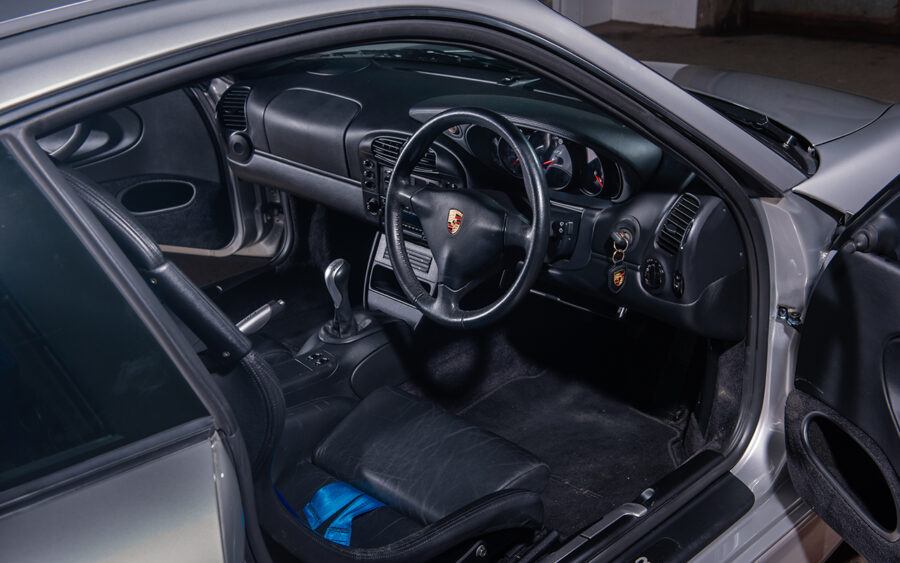
Interior and trim
“996 GT3s featured manually operated door mirrors, but came with electric windows,” Chris reveals. We’ve established air-conditioning was a no-cost option, but it’s one he sees as desirable. “Granted, air-conditioning systems sap a degree of power from an engine, but you’re likely to encounter traffic at a track anyway, meaning you’ll regularly be slowing down. Besides, even a GT3 with air-conditioning on the go is likely to be much more of a 911 than most owners are capable of exploiting. And, when pushing on hard with a wailing flat-six behind you, the cabin can get hot, which is why air-conditioning is a welcome addition to the specification of an early 996 GT3.”
Cars without stereos or cockpit cooling systems will feature a factory-fitted centre console delete panel (essentially a large cubby hole). All GT3s are noisier than their Carrera counterparts. “The 996 GT3 doesn’t feature much in the way of sound-deadening material,” Chris adds, pointing to the fact the simplest way to make a car quicker is to remove weight, such as heavy noise-cancelling (and, it should be said, vibration-reducing) layers of material from the cabin. Despite this elimination, the 996 GT3 still manages to be thirty kilograms heavier than the 996 Carrera. What it might bring in bulk, it certainly makes up for in power — the GT3 unleashes more than sixty extra galloping ponies over the base model.
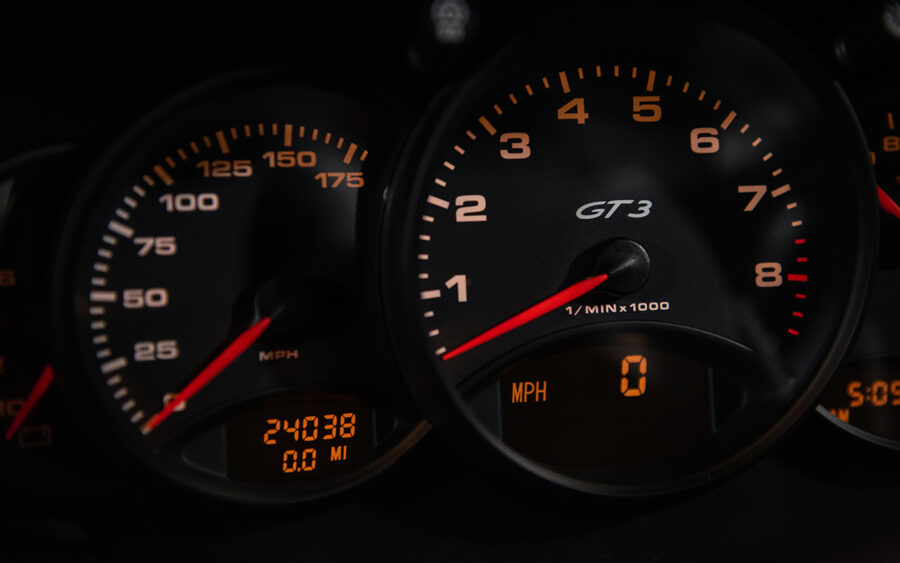
Porsche 996 GT3: our verdict
The first-generation 996 GT3 is the last road-going Porsche to be built on the factory’s motorsport production line and is the last Porsche to make use of a throttle cable. Aside from ABS, there are no other driver aids. Preuninger really did get things right first time. And, unlike later GT3s (and, of course, their even more hardcore RS derivatives), the original GT3 doesn’t shout about its identity. Let’s face it, from the outside, this could be a 996 Carrera carrying a factory Aerokit. Only the badge at the rear is the giveaway.
It’s the same story inside the car — those with a keen eye will spot the GT3 logo on the sill kick plates, rev counter and handbrake lever, but there’s precious little else to confirm what’s going on. Add the fact most original buyers took advantage of the no-cost audio and air-conditioning upgrades mentioned elsewhere in this buying guide and it becomes clear the original GT3 is very much the proverbial wolf in sheep’s clothing. And, we reckon, all the better for it.
“There’s currently a huge amount of interest in the first-generation GT3,” Chris observes. “Prices have shot up considerably in recent years. I don’t think it will be too long before 996 GT3 sales are regularly topping £100k. If you’re in the market for one of these cars, my advice is not to delay. Grab one while you still can.”






